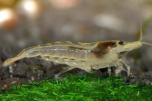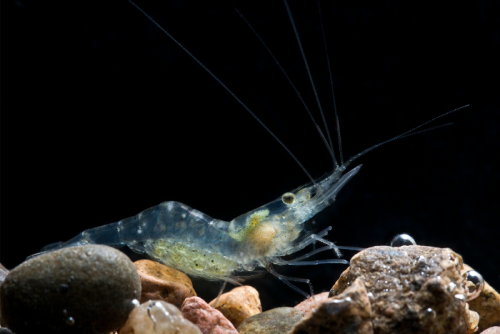10 Ghost Shrimp
The Ghost Shrimp, also known as American Glass Shrimp, has been in the freshwater aquarium hobby in the United States for as long as the hobby has been around. These shrimp are commonly found being sold as feeder shrimp to be fed to larger fish. They have a lifespan of 1-2 years, and when fully grown, they reach a size of 2 inches. They are available for purchase at a size of 1 inch.
Ghost Shrimp
The American Glass Shrimp has been in the aquarium hobby in The United States for as long as the hobby has been around. The American Glass Shrimp is often found being sold as a feeder shrimp, to be fed to larger fish.
Ghost Shrimp Behavior
Ghost Shrimp are non-aggressive and are quite active. In an aquarium that has no predators, Ghost Shrimp will often be observed grazing on algae on aquarium plants, decorations, and on the substrate. When fed, the shrimp will often form large groups that are quite striking in appearance.
Ghost Shrimp Care
Most Ghost Shrimp that are found in America are sold as feeder shrimp and will not have a long life span in the home aquarium due to the conditions they are shipped to the store in and kept in the store. If the shrimp do survive, or if a captive raised stock is available, caring for the American Glass Shrimp is fairly easy. A well established aquarium will support a fairly large population of this aquarium shrimp.
You can find the full Ghost Shrimp care sheet in the link.
Buying Ghost Shrimp
As with all aquatic invertebrates, it is important to make sure copper does not get into the aquarium. Copper is toxic to all Dwarf Shrimp. Many medications contain elevated levels of copper, so it is recommended not to medicate an aquarium with Dwarf Shrimp in it.
Special Notes
Many shrimp are labeled Ghost Shrimp that are not American Glass Shrimp. These are often clear shrimp that look similar, but are not the same shrimp.
Scientific Name: Palaemonetes genus
Other Scientific Names: None
Common Name: Ghost Shrimp
Other Common Name: Glass Shrimp, Freshwater Glass Shrimp, American Freshwater Glass Shrimp
Temperament: Aggressive
Breeding: Hard
Care Level: Easy
Origin: North America
Found in Wild: Yes
Life Span: 1-2 Years
Gestation Period: 30 Days
Full Grown Size: 2”
Approximate Purchase Size: 1”
General Water Parameters:
pH Range: 7.0-7.8
Temperature Range: 65-82 °F
GH Range: 4-8
KH Range: 3-15
TDS Range: 150-250
The Shrimp Farm’s Water Parameters:
pH Range: 7.2
Temperature Range: 75 °F
GH Range: 7-9
KH Range: 8
TDS Range: 175-250
Currently Being Fed: Ebita Breed Quatro 2
How big do Ghost Shrimp get?
The females can reach up to around 1.6"/4 cm, while the males stay a bit smaller.
How many Ghost Shrimp can I keep per gallon?
You can keep an almost infinite amount of Ghost shrimp per gallon of aquarium water volume as long as you make sure to start with at least a 5-gallon tank. Stay on top of maintenance, and the colony should balance itself.
How long do Ghost Shrimp live?
Ghost shrimp's lifespan strongly depends on factors like water quality, diet, and temperature. In the right conditions, they can make it at least a year, even up to two.
How fast do Ghost Shrimp grow?
Pretty darn quickly! In the right conditions, they are able to grow from freshly hatched fry to breeding adults in 2-2.5 months.
Is Ghost Shrimp easy to Breed?
If optimal care requirements are met, the Ghost Shrimp is fairly easy to breed. It can be difficult to determine the sex of a Ghost Shrimp. The males are slightly smaller and have shorter, thinner tail sections. The females are larger with a longer and wider tail section. In our shop, we sell great Breeding Aids for you to help the breeding process go easier and faster.
Will different shrimp species breed with each other?
Yes, most Neocaridina species will breed with other Neocaridina species, and many Caridina species will breed with other Caridina species. Neocaridina species will not breed with Caridina species. It is not recommended to keep any species that may interbreed with each other. Check out our dwarf shrimp compatibility chart to see what shrimp will not interbreed with Ghost Shrimp.
How often do Ghost Shrimp molt?
Depends on their age! Ghost shrimp grow very quickly. This also means they molt a lot (at least every few days at first) until they reach their adult size, after which they slow down to about once a month.
What is the diet of Ghost Shrimp?
Ghost Shrimp are omnivores and share the same diet that most Dwarf Shrimp enjoy. They will eat just about anything in an aquarium, that is edible. Ghost Shrimp will eat the algae that naturally occurs in aquariums. Sinking pellets and blanched (boiled until soft) vegetables make good foods for dwarf shrimp, as well. But Ghost will oftentimes need supplemental feedings. Aquarium foods intended for bottom feeders and aquatic invertebrates are readily accepted, as are blanched vegetables (boiled until soft). You can find wide veracity of good shrimp foods in our shop. The Ghost Shrimp you order are currently eating Ebita Breed - Quarto 2.
What type of filter should I use?
A sponge filter is the best filter for a shrimp-only aquarium. Another good option is a corner box filter. Most power filters will suck smaller shrimp into the filter and kill them, so they are not recommended. In our shop, you can find a nice selection of filters that are safe for shrimps.
What are the best plants for Ghost Shrimp?
Any aquarium plants are great if you'd like to keep Ghost shrimp! They love to hide in and forage on the leaves. A few personal favorites are java moss, floating plants, and hair grass (Eleocharis acicularis). All the plants we sell are great for Ghost Shrimp. You can find out more about Freshwater aquarium plants here.
What are the best tank mates for Ghost Shrimp?
Ghost shrimp, like other dwarf shrimp, are very peaceful and vulnerable creatures. They will never harm any tankmates but will easily fall prey to hungry fish. It might be a good idea to set up a single-species aquarium. Still, peaceful inverts like other shrimp and small snails are always a possibility. You can check out the dwarf shrimp compatibility chart to see what shrimp will be a great match for the Ghost Shrimp.
Aquarists who don't mind losing some of their stock can combine them with a number of peaceful species, including the popular Corydoras and Otocinclus catfish, small schooling fish, and more. Learn more about The Best Types Of Fish For Your Shrimp Aquarium here. The shrimp should usually breed quickly enough to sustain the population despite regular casualties, provided there are enough hiding places. Not enough hiding places for your shrimp? We have some great hiding decorations in our shop.
What is the best way to Acclimate my new Ghost Shrimp?
When adding new shrimp into your established already existing tank, it is important to take the proper steps in introducing and acclimating them into their new home. The whole process is extremely stressful for the shrimp. Acclimation is important for shrimp as it allows them time to adjust to the temperature and parameters of their new environment. By doing this correctly, you will reduce the chances of shock or death of your new shrimps. You can find the step-by-step process of acclimating shrimp here.
Is your question not listed above?
If you don't see the answer to your question, give us a quick email, and we will get back to you asap.
-
 15 Cleaner Shrimp$27.99
15 Cleaner Shrimp$27.99



 Shrimp
Shrimp Fish
Fish Crab &
Crab & Plants
Plants Foods
Foods Snails
Snails






